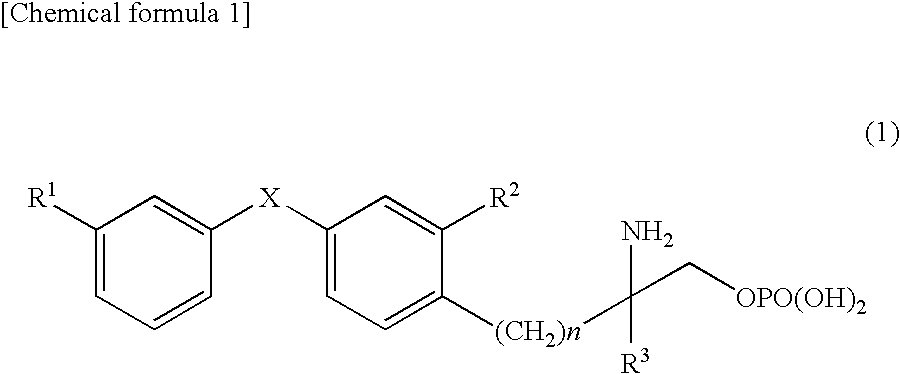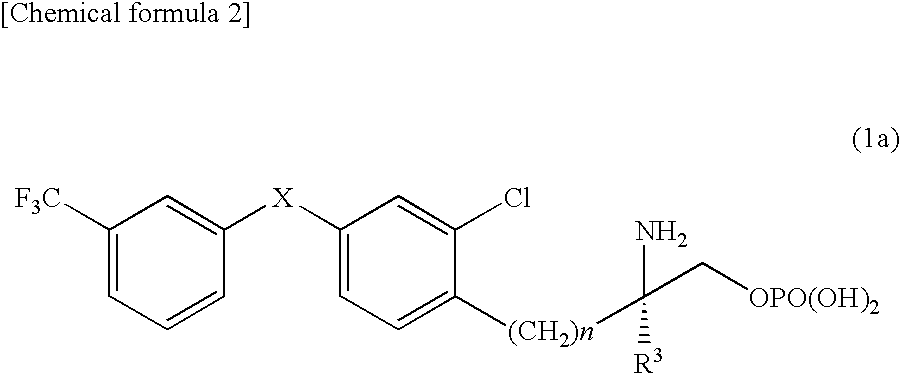Amino phosphate derivative and s1p receptor modulator having same as an active ingredient
a technology of s1p receptor and amino phosphate, which is applied in the field of high-safety drugs, can solve the problems that not all s1p receptor agonist drugs provide a desirable action on the body, and achieve the effect of excellent s1p receptor modulatory action
- Summary
- Abstract
- Description
- Claims
- Application Information
AI Technical Summary
Benefits of technology
Problems solved by technology
Method used
Image
Examples
reference example 1
O-3-(difluoromethyl)phenyldimethylcarbamothioate
[0065]
[0066]1,4-diazabicyclo[2.2.2]octane (9.03 g) and dimethylthiocarbamoyl chloride (9.95 g) were added into a solution of 3-difluoromethylphenol (6.44 g) in N,N-dimethylformamide (149 mL), and the resultant solution was stirred for 4 hours at room temperature. Water was added into the reaction mixture, extracted with ethyl acetate, washed with water and saturated brine in that order, and then dried over anhydrous sodium sulfate. The solvent was removed by distillation, and the resultant residue was purified by silica gel column chromatography (hexane:ethyl acetate=3:1) to obtain the target product (7.04 g) as a colorless oil. 1H-NMR (CDCl3, 400 MHz): δ 3.36 (3H, s), 3.46 (3H, s), 6.66 (1H, t, J=57 Hz), 7.19 (1H, dt, J=7.9, 1.2 Hz), 7.23 (1H, br s), 7.39 (1H, d, J=7.9 Hz), 7.48 (1H, t, J=7.9 Hz).
[0067]EIMS (+): 231 [M]+.
reference example 2
S-3-(difluoromethyl)phenyldimethylcarbamothioate
[0068]
[0069]A solution of the compound of Reference Example 1 (2.34 g) in diphenyl ether (12 g) was stirred at 250° C. for 2.5 hours. The temperature of the reaction solution was returned to room temperature, and the resultant residue was purified by silica gel column chromatography (hexane:ethyl acetate=3:2) to obtain the target product (1.92 g) as a yellow oil.
[0070]1H-NMR (CDCl3, 400 MHz): δ 3.04 (3H, s), 3.10 (3H, s), 6.65 (1H, t, J=57 Hz), 7.48 (1H, t, J=7.9 Hz), 7.54 (1H, d, J=7.9 Hz), 7.61 (1H, t, J=7.9 Hz), 7.64 (1H, s).
[0071]EIMS (+): 231 [M]+.
reference example 3
2-Chloro-4-(3-difluoromethylphenylthio)benzaldehyde
[0072]
[0073]A solution of the compound of Reference Example 2 (4.17 g) in diethyl ether (12 mL) was added dropwise under ice cooling to a solution of lithium aluminum hydride (959 mg) in diethyl ether (48 mL). The resultant solution was then stirred for 20 minutes under ice cooling. 0.5 mol / L hydrochloric acid (30 mL) was added to the reaction mixture, extracted with diethyl ether, washed with water and saturated brine in that order, and then dried over anhydrous sodium sulfate. The solvent was evaporated, and the resultant residue was reacted with 2-chloro-4-fluorobenzaldehyde according to the same experiment procedures as in Reference Example 1 of the pamphlet of WO 03029184 to obtain the target product as a colorless powder.
[0074]1H-NMR (CDCl3, 400 MHz) δ 6.67 (1H, t, J=56 Hz), 7.09 (1H, dd, J=7.9, 1.8 Hz), 7.16 (1H, d, J=7.9 Hz), 7.53-7.64 (3H, m), 7.68 (1H, s), 7.79 (1H, d, J=7.9 Hz), 10.37 (1H, s)
[0075]EIMS (+): 298 [M]+.
PUM
 Login to View More
Login to View More Abstract
Description
Claims
Application Information
 Login to View More
Login to View More - R&D
- Intellectual Property
- Life Sciences
- Materials
- Tech Scout
- Unparalleled Data Quality
- Higher Quality Content
- 60% Fewer Hallucinations
Browse by: Latest US Patents, China's latest patents, Technical Efficacy Thesaurus, Application Domain, Technology Topic, Popular Technical Reports.
© 2025 PatSnap. All rights reserved.Legal|Privacy policy|Modern Slavery Act Transparency Statement|Sitemap|About US| Contact US: help@patsnap.com



